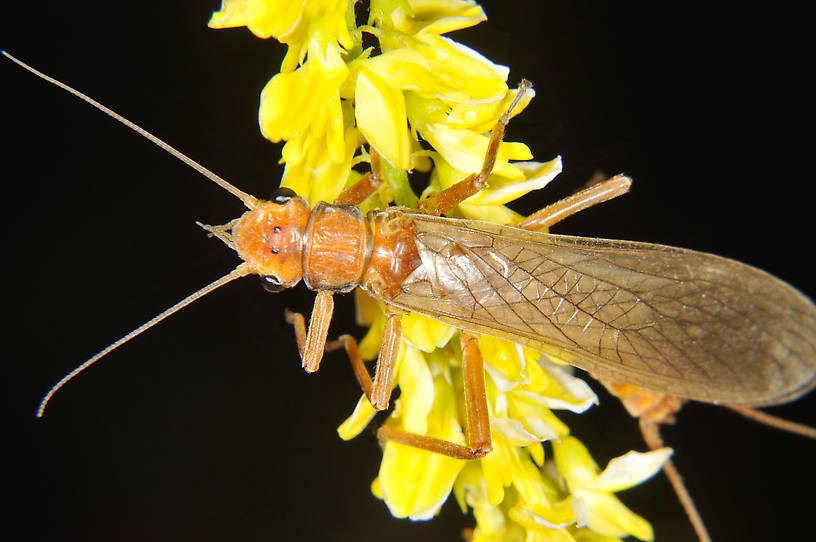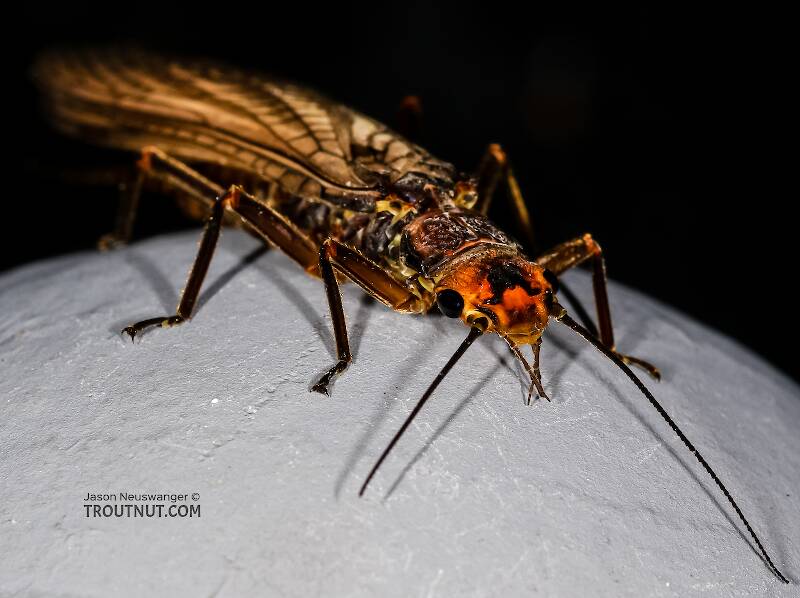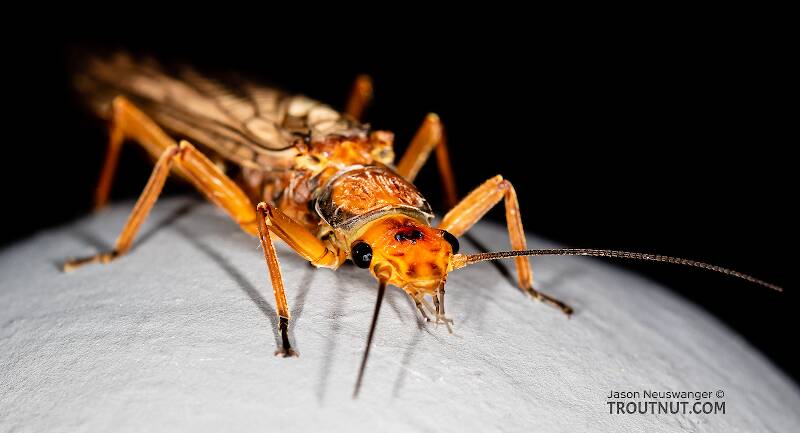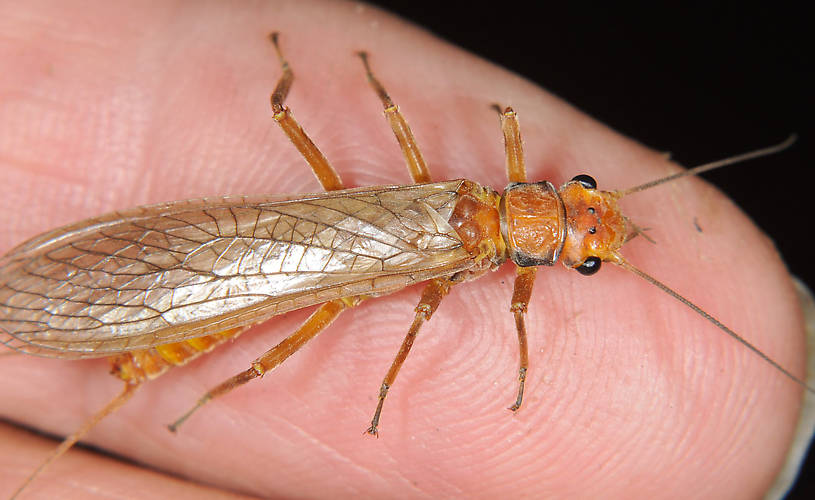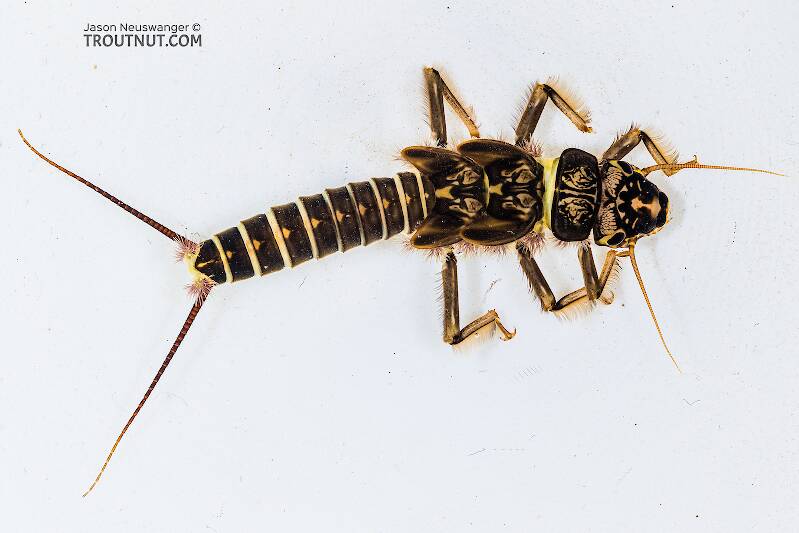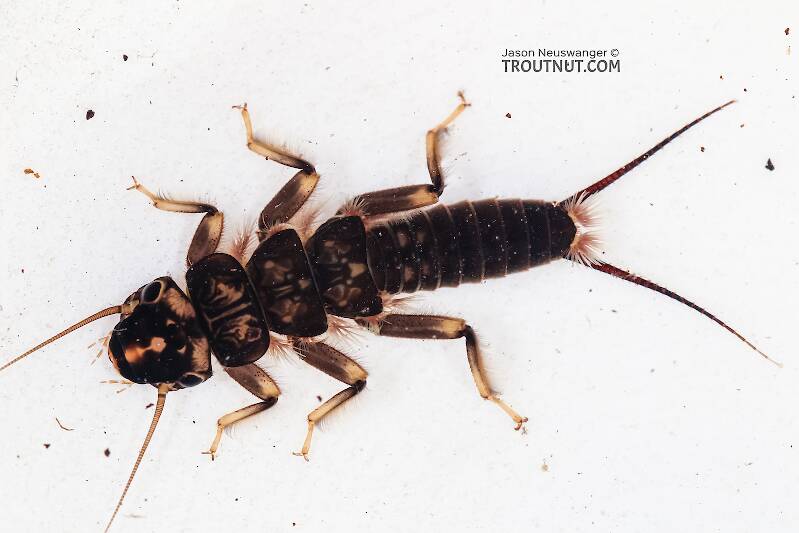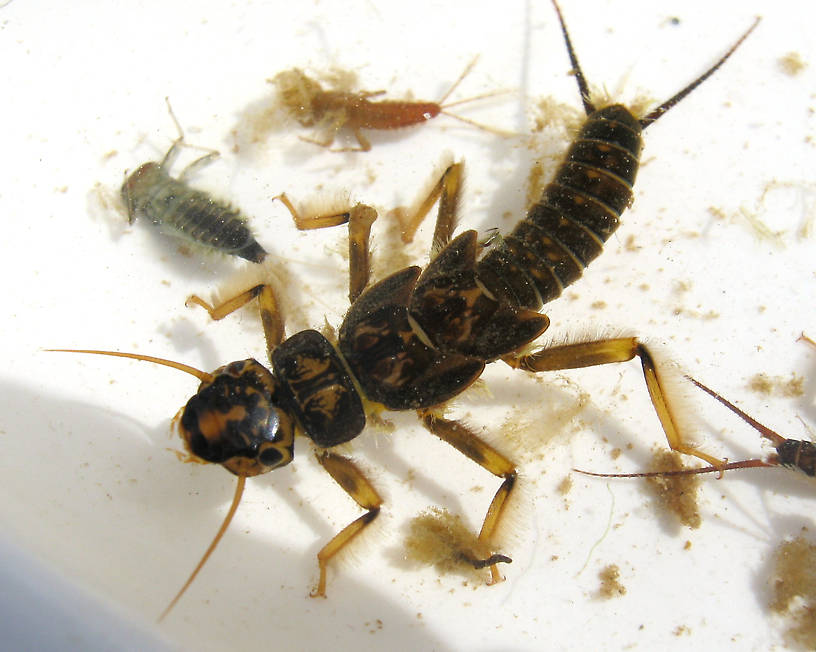
Blue-winged Olives
Baetis
Tiny Baetis mayflies are perhaps the most commonly encountered and imitated by anglers on all American trout streams due to their great abundance, widespread distribution, and trout-friendly emergence habits.
Featured on the forum

This seems to be a young larva of Limnephilus. Although not clear in the picture, several ventral abdominal segments have chloride epithelia.

Troutnut is a project started in 2003 by salmonid ecologist Jason "Troutnut" Neuswanger to help anglers and
fly tyers unabashedly embrace the entomological side of the sport. Learn more about Troutnut or
support the project for an enhanced experience here.
Stonefly Species Hesperoperla pacifica (Golden Stones)
This species is perhaps better known by anglers under its former scientific name, Acroneuria pacifica. On many rivers they share the same hatching cycle with the famous Pteronarcys californica (Salmonfly) that often overshadows them. Both can be found on the water at the same time in tremendous numbers. Anglers can become so mesmerized by the size and legend of the famous Salmonflies that they fail to pay attention to the smaller and more somber Perlidae. Rest assured the trout don't make that mistake. It pays to keep an eye out for which species the fish are most interested in on a particular stretch or run. Many boulders streamside can be covered with the empty husks of both species intermixed. See the Perlidae Hatch Page for more information.
Older anglers with an extensive background fishing in the Rockies often refer to them as Brown Willowflies or simply "Willows". Historically, Golden Stonefly was a name used on the West Coast to describe members of the family Perlidae (it seems everything from California was gold back then). While in the Rockies, Willow fly was the common name settlers and ranchers used. Over time, the most prominent species on the coast, Calineuria californica became universally accepted in angling literature as the Golden Stone, while Hesperoperla pacifica as the most prominent species in the Rockies was usually listed as Brown Willowfly. In 1955 in Matching the Hatch, Ernest Schwiebert wrote that this species is partially responsible for the "willowfly" hatches of the West, and he described some Colorado mating flights as "really a spectacle to see." Even late into the '80's popular angler entomologies such as Rick Hafele's "Western Hatches" made this distinction. The name Willowfly has largely been dropped from the lexicon of the latest generation of anglers, at least when referring to this species. In an interesting twist of irony, it is Hesperoperla pacifica that now bears the scientific common name Golden Stonefly - not Calineuria californica.
The nymphs have prominent anal gills making them easy to tell apart from Calineuria. They are also often less dramatically marked and have an hour glass or similar shaped mark running vertically on the front of their heads. The more somber appearance holds true for the adults as well. The male adults of Calineuria and Hesperoperla are easier to tell apart by looking at their hammers. Both are quadrangular but Hesperoperla is wider than long.
Older anglers with an extensive background fishing in the Rockies often refer to them as Brown Willowflies or simply "Willows". Historically, Golden Stonefly was a name used on the West Coast to describe members of the family Perlidae (it seems everything from California was gold back then). While in the Rockies, Willow fly was the common name settlers and ranchers used. Over time, the most prominent species on the coast, Calineuria californica became universally accepted in angling literature as the Golden Stone, while Hesperoperla pacifica as the most prominent species in the Rockies was usually listed as Brown Willowfly. In 1955 in Matching the Hatch, Ernest Schwiebert wrote that this species is partially responsible for the "willowfly" hatches of the West, and he described some Colorado mating flights as "really a spectacle to see." Even late into the '80's popular angler entomologies such as Rick Hafele's "Western Hatches" made this distinction. The name Willowfly has largely been dropped from the lexicon of the latest generation of anglers, at least when referring to this species. In an interesting twist of irony, it is Hesperoperla pacifica that now bears the scientific common name Golden Stonefly - not Calineuria californica.
The nymphs have prominent anal gills making them easy to tell apart from Calineuria. They are also often less dramatically marked and have an hour glass or similar shaped mark running vertically on the front of their heads. The more somber appearance holds true for the adults as well. The male adults of Calineuria and Hesperoperla are easier to tell apart by looking at their hammers. Both are quadrangular but Hesperoperla is wider than long.
Where & when
It is important in the West.In 44 records from GBIF, adults of this species have mostly been collected during July (34%), June (25%), May (20%), and April (9%).
In 16 records from GBIF, this species has been collected at elevations ranging from 1969 to 8632 ft, with an average (median) of 6339 ft.
Species Range
Specimens of the Stonefly Species Hesperoperla pacifica
1 Male Adult
4 Female Adults
4 Nymphs
Start a Discussion of Hesperoperla pacifica
References
- Schwiebert, Ernest G. 1955. Matching the Hatch. MacMillan Publishing Company.
- Swisher, Doug and Carl Richards. 2000. Selective Trout. The Lyons Press.
Stonefly Species Hesperoperla pacifica (Golden Stones)
Species Range
Common Names
Resources
- NatureServe
- Integrated Taxonomic Information System
- Global Biodiversity Information Facility
- Described by Banks, N. (1900) New genera and species of Nearctic Neuropteroid Insects. Transactions of the American Entomological Society 26, 239–259. [1899]


